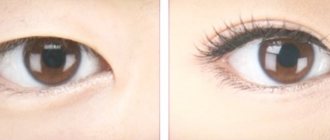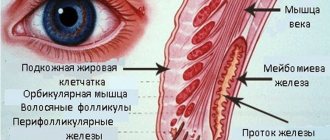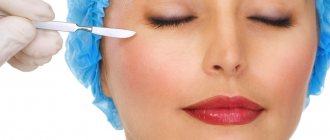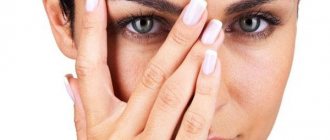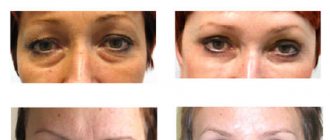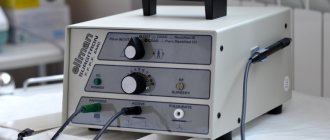An operation to correct the shape of the eyes, as well as to remove excess skin, is called blepharoplasty. This correction allows you to solve a number of problems - get rid of “bags” under the eyes, remove sagging, eliminate age-related changes.
Blepharoplasty is indicated for patients with the following defects around the eyes:
- wrinkles,
- fat deposits,
- flabbiness,
- drooping upper eyelid.
The operation can be performed repeatedly and is quite gentle. It is usually performed after the age of 35.
Contraindications to the procedure are bleeding disorders, HIV, hepatitis, increased intraocular and blood pressure.
General recommendations
Immediately after correction, a bandage is applied to the injured area. The patient notes swelling and cyanosis, which increase in the first 3 days, after which they subside.
To speed up the recovery process, doctors recommend monitoring your diet and regimen:
- ensure complete rest on the first day (do not overexert yourself physically, do not be nervous);
- sleep on your back with a large pillow under your head - this will minimize swelling;
- follow a diet - give up fatty, salty, smoked foods, in favor of vegetables and fruits (except citrus fruits: they impair blood clotting), dairy products, lean meat;
- protect your skin from the sun - do not leave the house or go out, but wear sunglasses;
- follow a daily routine - sleep 8 hours, going to bed at 22.00;
- Provide peace to your eyes - watch less TV, read, sit in front of the computer. The ideal option is to listen to music with your eyes closed.
You can take any medications after blepharoplasty only after consulting a doctor. As a rule, he prohibits drugs that worsen the clotting process (aspirin).
It is also forbidden to bend over or turn your head sharply, as in these cases the pressure on the eyes increases.
Possible consequences of blepharoplasty
Blepharoplasty is plastic surgery. Therefore, like any other type of surgical intervention, complications are inherent in it.
- Swelling. This phenomenon is considered the absolute norm. However, if it does not go away after 7 days and is accompanied by double vision, impaired quality of vision and severe headache, then this is a dangerous consequence of blepharoplasty. One of the reasons for prolonged swelling is infection. This fact is confirmed by the discharge of pus and severe pain in the incision area.
- Subcutaneous hematoma. Formed when blood vessels are damaged and blood accumulates. It may appear immediately after surgery or after several days. At the site of an old hematoma, a dense swelling forms.
- Retrobulbar hematoma. Appears when a vessel bursts behind the eyeball. Accompanied by bulging of the eyeball, severe pain, decreased vision, and limited eye mobility.
- Eversion of the century. May occur when large amounts of skin are removed. In this case, it is impossible to close the eye completely, and its mucous membrane begins to dry out. This defect is corrected by repeated surgery.
- Infection caused by the surgeon’s failure to maintain hygiene. Treated by prescribing antibiotics.
- Seams coming apart.
- Asymmetry of the eyelids. It is observed due to improper suturing and severe scarring.
Complications of blepharoplasty can be different. Among them are also noted: the formation of a cyst at the site of the scar, the formation of keloid scars, ptosis (drooping of the eyelid), dry conjunctivitis.
Caring for the affected area
It is a mistake to believe that after blepharoplasty only the stitches need care. It is also important to treat the skin around the eyes and use medications to reduce dryness.
A sterile dressing, which is applied to the stitches themselves, is removed after a few days. Additionally, the doctor prescribes antiseptic rinsing solutions and wound-healing medications, for example, Levomekol ointment. After removing the sutures, it is recommended to apply absorbable medications that effectively relieve redness.
In general, daily skin care after blepharoplasty includes:
- repeated application of cold compresses in the first few days – they relieve swelling;
- using a special patch;
- application of hypoallergenic and non-comedogenic (clean fat ducts), but only after removal of stitches and with the permission of a doctor;
- treating the upper eyelids with a product containing Chinese mushroom extract – it increases the elasticity of the skin.
Note! After transconjunctival blepharoplasty, ointments are placed under the lower eyelid (on the incision area), which can cause discomfort and temporary blurred vision. There is no need to worry, they are normal variants.
To relieve inflammation and prevent dryness, you can instill drops like artificial tears. The doctor will help you choose them. Other manipulations may be prescribed according to individual indications.
To eliminate hematomas after blepharoplasty of the upper and lower eyelids, postoperative care must necessarily include the application of Lyoton ointment.
In what cases is blepharoplasty not performed?
Contour eyelid surgery is not performed if the patient has chronic, infectious pathologies, as well as diseases in the acute stage. Here are more contraindications to blepharoplasty that should be taken into account if you want to go on the operating table.
- Disturbances in the functioning of the endocrine system.
- Regular increase in intraocular pressure.
- Malignant tumors.
- Blood diseases - anemia, low hemoglobin.
- Diseases of blood vessels and heart.
- A contraindication to blepharoplasty is also a severe stage of diabetes mellitus.
- Hypertension.
Important: Blepharoplasty of the lower and upper eyelids is not performed if the patient has frequent relapses of conjunctivitis, dry eye syndrome, glaucoma, or blepharitis. Surgical intervention is possible only after treatment of these pathologies.
Washing, makeup
On the first day, it is forbidden not only to use any cosmetic products, but also to wash your face. With each passing day, the patient’s capabilities expand:
- Already 24 hours after the procedure, he is allowed to carefully wash his face. The main thing is to use cool water (it increases blood flow and speeds up the regeneration process) and avoid the affected area: water should not get on the seams under the bandage.
- After 5 days, you can go to a qualified specialist for a massage.
- After removing the stitches after blepharoplasty, it is allowed to apply masks to the face, avoiding injured areas. This usually happens on the 7th day.
- Decorative cosmetics can be used no earlier than after 14 days. If there are no complications, it can also be applied to the area around the eyes.
- Scrubs are indicated only after 2 or more weeks.
For the entire rehabilitation period, it is forbidden to touch the damaged areas with your hands, or to pull or rub the eyelids. Otherwise, there is a high risk of complications and infection.
(1 ratings)
Blepharoplasty price
The price for blepharoplasty surgery varies. And it depends on the region of the country and the clinic in which the operation is planned. On average, the cost of eyelid rhinoplasty ranges from 40,000-150,000 rubles. The price for eyelid surgery (lower) is from 60,000 to 75,000 rubles, upper – 50,000-75,000 rubles. Circular plastic surgery is considered the most expensive - up to 90,000-145,000 rubles. Laser surgery costs approximately 27,000-50,000 rubles.
Eyelid blepharoplasty will help combat the signs of aging and make you feel young and confident again.
0 0 vote
Article Rating
Laser exposure
Laser treatment is a plastic procedure in which a laser beam is used instead of a scalpel. In most cases, a CO2 laser is used.
The procedure is recommended for:
deliverance from the impending age;- raising the drooping corners of the eyes;
- destruction of wrinkles;
- correction of eye asymmetry.
Contraindications:
- inflammatory processes in the body;
- increased sensitivity to laser exposure;
- oncology;
- exacerbation of chronic diseases;
- bleeding disorders;
- eye diseases;
- HIV.
Pros of the procedure:
- no scars or other marks after;
- the possibility of bleeding is excluded;
- minimizing the likelihood of damage to the eyeball;
- small amount of time.
The disadvantages are:
- temporary disturbance of tearing of the eyes;
- puffiness around the eyes;
- and a large list of possible complications.
Compared to blepharoplasty, laser treatment is safer because it does not damage the skin and helps not only remove swelling, tighten the eyelid, but also correct its shape.
| In Moscow | In St. Petersburg | |
| Average price (in rubles) | 10000-70000 | 5000-20000 |
You can learn more about laser blepharoplasty from the video:
Method of anesthesia and duration of surgery
When performing any type of blepharoplasty, the patient needs pain relief. Either local local anesthesia, or local anesthesia with premedication (preliminary administration of tranquilizers intravenously), or general anesthesia is used. The choice of anesthesia method depends on the volume and duration of surgery. Thus, a combined correction can be performed under general anesthesia, when several manipulations are performed at once.
The duration of the operation is from 30 minutes to 3 hours. At the end of the procedure, the patient should remain in a horizontal position for an hour with a cold compress on the eyes. Then he is allowed to get up and go home (preferably accompanied by relatives or close people). No hospitalization required.
Reviews
Listed below are 3 reviews and before and after photos from patients of different ages and videos of those who went through the procedure, and more detailed material on this topic can be read here:
OLGA, 35 YEARS OLD, SMOLENSK:
“I had blepharoplasty of the lower eyelids according to the doctor’s instructions. I was tired of severe swelling that arose due to kidney failure.
After the treatment, there were bags under my eyes, which I decided to remove. I talked to my cosmetologist, she recommended the clinic. It was scary to take this step; the operation was not as painless as they had promised. Maybe I'm the only one who feels this way.
But after a month I realized that the result was worth it.”
GENNADY, 56 YEARS OLD, STAVROPOL:
“With age, I began to suffer from swelling of the eyes. I went to an ophthalmologist, who sent me to a surgeon. The plastic doctor said that it is necessary to remove the fatty tissue under the eyes; fluid is deposited in it during sleep, especially if I drink.
I don’t remember how the operation went; I chose general anesthesia. It was difficult to heal - I couldn’t touch my eyes, I couldn’t drink, I couldn’t work calmly. But then everything returned to normal, after a couple of months I completely forgot about my problem, now I’m happy.”
IRINA, 63 YEARS OLD, KALUGA:
“I am a business person, I have worked as an engineer all my life.
Maybe because of the stress at work, problems with the eyes began to appear - constant swelling. The skin is no longer young, the eyelids have sagged a lot, and bags have appeared. I decided to undergo circumferential blepharoplasty. The operation went smoothly, I took a lot of painkillers for the first 2-3 days, but then it was very difficult. For a week I slept a lot, could not work normally, look at the monitor or be in the sun.
Then somehow it became easier and easier. I wouldn’t sign up for this the second time, but everyone around me says that I’m 10 years younger.”
Objectives of the operation
The main goal of blepharoplasty is the correction of medical or aesthetic defects of the eyelids.
Deformation of the eyelids can occur due to various reasons:
- age-related changes;
- inflammatory diseases:
- congenital pathology;
- injuries or burns;
- postoperative complications.
The goal of eyelid surgery is to eliminate or smooth out the existing deformation as much as possible, restore an open look, lift drooping corners of the eyes, remove drooping eyelids, create a smooth and symmetrical contour, and reduce the number and severity of periocular wrinkles.
Blepharoplasty is also used for purely aesthetic purposes: when the eyelids are not deformed, but the patient seeks to change the shape and shape of the eyes. Most often, the Asian section is transformed into a European one; It is also possible to correct an excessively narrow or asymmetrical ocular incision.
Question answer
To see the results of the operation, you should wait about 2-3 weeks. During this time, the seam will turn pale and become almost invisible. But the final outcome of the intervention can be assessed after several months.
This depends on each case individually. But, often, doctors are inclined to use local anesthesia. The patient does not feel anything while the surgeon is working.
Postoperative scars dissolve after a certain time. This will take about 2-3 months. They won't be visible.
Color correction
Since the stains lighten over time, the need for a dense coating disappears. You can use cosmetics that imitate the natural color of the skin. These are concealers with color-correcting pigments that are more translucent than a solid base. Their color should be chosen in such a way as to tint the spot to match the normal, natural color of the skin.
For example, you can disguise redness with a green tone, yellowness with blue or blue, cyanosis or violet with yellow tones. Color-correcting concealers should be applied by gently patting with your fingertips or using a sponge. The makeup is completed with a foundation that matches the skin. It is better to use a clean sponge or sponge.
We recommend: What eye drops are needed after blepharoplasty?


